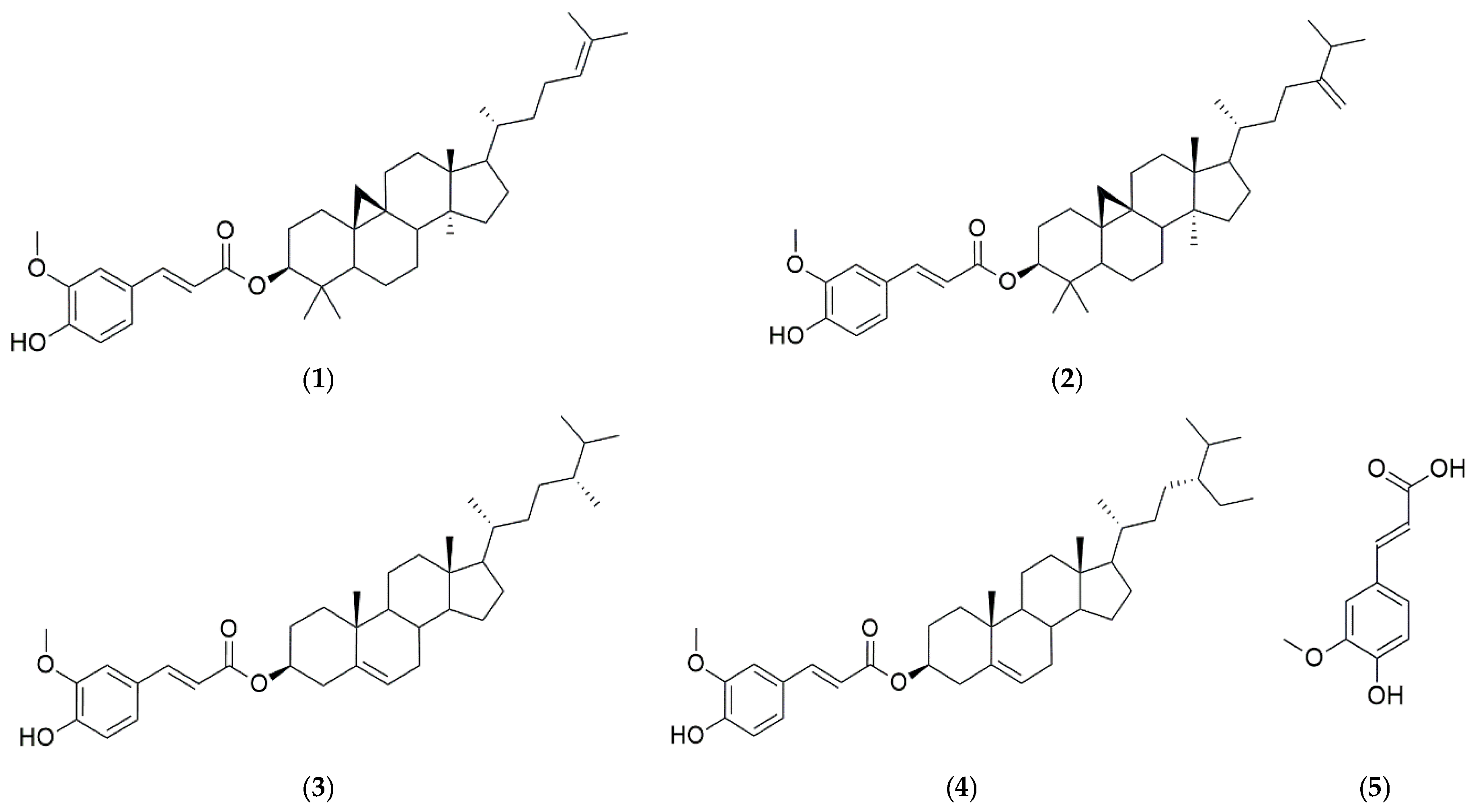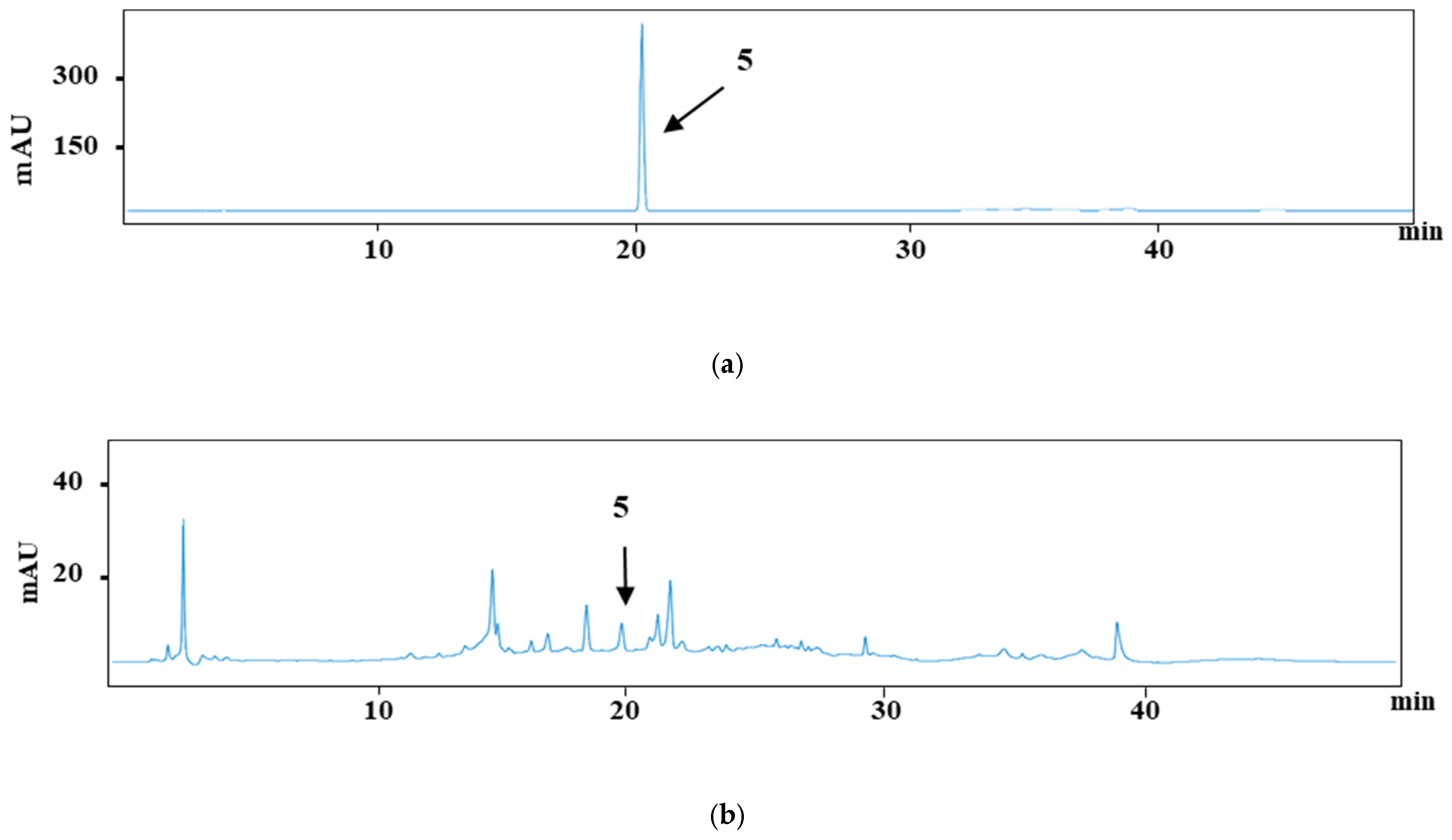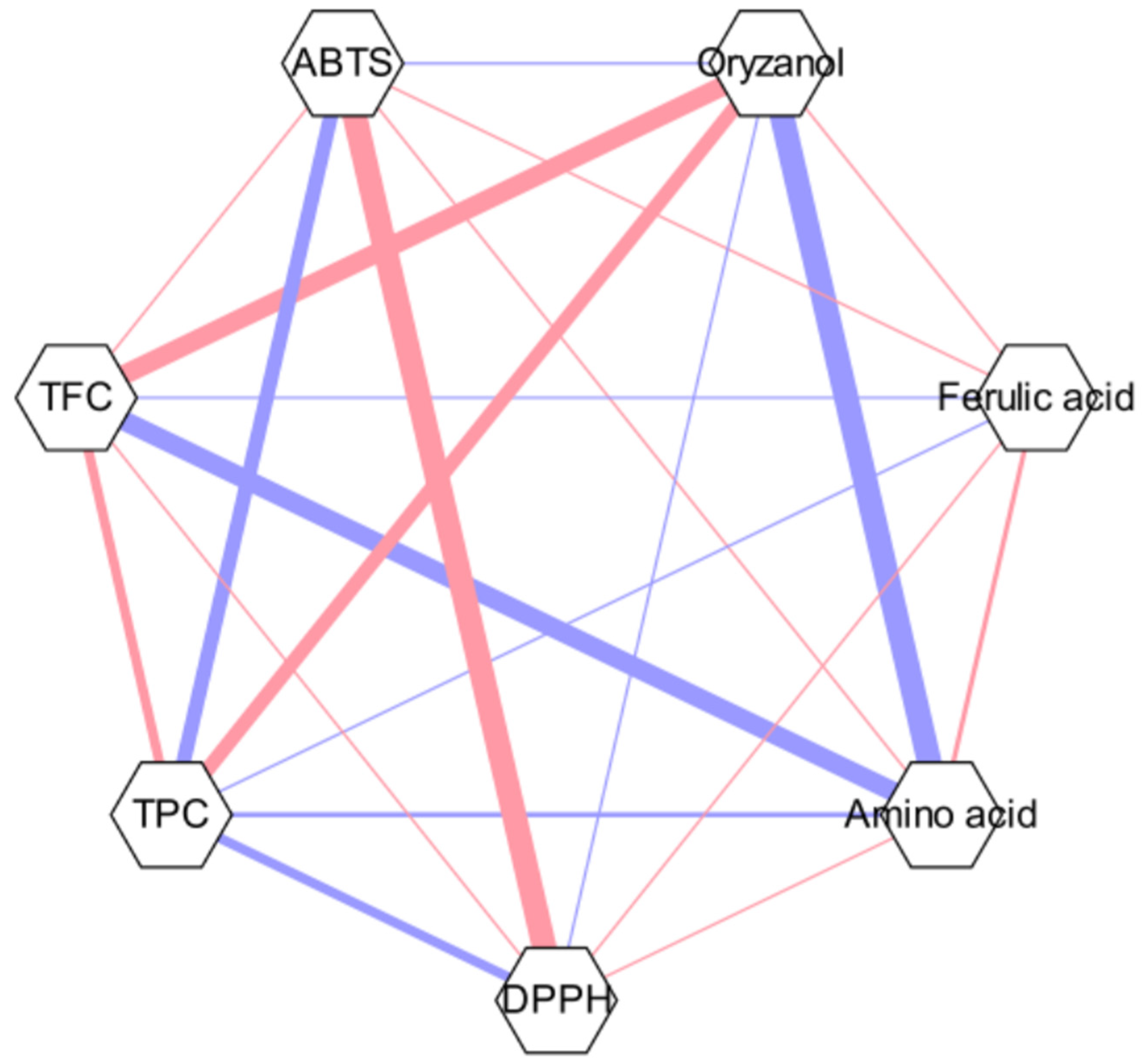Comparative Analysis of Chemical Profiles and Bioactive Properties in Six Pigmented and Non-Pigmented Rice Varieties
Abstract
1. Introduction
2. Materials and Methods
2.1. Plant Materials
2.2. Chemicals and Reagents
2.3. Instruments
2.4. Extraction of Pigmented and Non-Pigmented Rice Samples
2.5. Total Phenolic Contents
2.6. Total Flavonoid Contents
2.7. ABTS•+ Radical-Scavenging Activity
2.8. DPPH• Radical-Scavenging Activity
2.9. Preparation Conditions for Free Amino Acid Analysis
2.10. Preparation of Standard and Sample Solutions for Three HPLC Analyses
2.11. HPLC Determination of γ-Oryzanol, Ferulic Acid, and Free Amino Acids
2.12. Limit of Detection (LOD) and Limit of Quantification (LOQ)
2.13. Calibration Curves
2.14. Statistical Analysis
3. Results
3.1. Total Phenolic and Flavonoid Contents
3.2. Antioxidant Activity
3.3. Contents of γ-Oryzanol and Ferulic Acid
3.4. Free Amino Acid Contents
4. Discussion
5. Conclusions
Author Contributions
Funding
Data Availability Statement
Acknowledgments
Conflicts of Interest
References
- Chaudhari, P.R.; Tamrakar, N.; Singh, L.; Santhakumar, A.B. Rice nutritional and medicinal properties: A review article. J. Pharmacogn. Phytochem. 2018, 7, 150–156. [Google Scholar]
- Son, J.S.; Do, V.B.; Kim, K.O.; Cho, M.S.; Suwonsichon, T.; Valentin, D. Understanding the effect of culture on food representations using word associations: The case of “rice” and “good rice”. Food Qual. Prefer. 2014, 31, 3848. [Google Scholar] [CrossRef]
- Khan, M.N.; Ali, S.; Yaseen, T.; Ullah, S.; Zaman, A.; Iqbal, M.; Shah, S. Eco-taxonomic study of family Poaceae (Gramineae). RADS J. Biol. Res. Appl. Sci. 2020, 10, 63–75. [Google Scholar] [CrossRef]
- Jeong, O.Y.; Park, H.S.; Baek, M.K.; Kim, W.J.; Lee, G.M.; Lee, C.M.; Bombay, M.; Ancheta, M.B.; Lee, J.H. Review of rice in Korea: Current status, future prospects, and comparisons with rice in other countries. J. Crop Sci. Biotechnol. 2020, 24, 1–11. [Google Scholar] [CrossRef]
- Nigudenm, B.A.; Hashim, M.; Shamsudin, R.; Che Man, H. Rice for food security: Revisiting its production, diversity, rice milling process and nutrient content. Agriculture 2022, 12, 741. [Google Scholar] [CrossRef]
- Amagliani, L.; O’Regan, J.; Kelly, A.L.; O’Mahony, J.A. The composition, extraction, functionality and applications of rice proteins: A review. Trends Food Sci. Technol. 2017, 64, 1–12. [Google Scholar] [CrossRef]
- Samyor, D.; Das, A.B.; Deka, S.C. Pigmented rice a potential source of bioactive compounds: A review. Int. J. Food Sci. Technol. 2017, 52, 1073–1081. [Google Scholar]
- Mbanjo, E.G.N.; Kretzschmar, T.; Jones, H.; Ereful, N.; Blanchard, C.; Boyd, L.A.; Sreenivasulu, N. The genetic basis and nutritional benefits of pigmented rice grain. Front. Genet. 2020, 11, 229. [Google Scholar] [CrossRef]
- Lee, H.Y.; Cho, D.Y.; Jeong, J.B.; Lee, J.H.; Lee, G.Y.; Jang, M.Y.; Lee, J.H.; Cho, K.M. Chemical compositions before and after lactic acid fermentation of isoflavone-enriched soybean leaves and their anti-obesity and gut microbiota distribution effects. Nutrients 2024, 16, 1693. [Google Scholar] [CrossRef]
- Zhao, S.; Fu, S.; Cao, Z.; Liu, H.; Huang, S.; Li, C.; Zhang, Z.; Yang, H.L.; Wang, S.; Luo, J.; et al. OsUGT88C3 encodes a UDP-glycosyltransferase responsible for biosynthesis of malvidin 3-O-galactoside in rice. Plants 2024, 13, 697. [Google Scholar] [CrossRef]
- Xia, D.; Zhou, H.; Wang, Y.; Li, P.; Fu, P.; Wu, B.; He, Y. How rice organs are colored: The genetic basis of anthocyanin biosynthesis in rice. Crop J. 2021, 9, 598–608. [Google Scholar] [CrossRef]
- Lakshmi, S.; Goudar, G.; Singh, M.; Dhaliwal, H.S.; Sharma, P.; Longvah, T. Variability in resistant starch, vitamins, carotenoids, phytochemicals and in-vitro antioxidant properties among diverse pigmented grains. J. Food Meas. Charact. 2021, 15, 2774–2789. [Google Scholar] [CrossRef]
- Irakli, M.N.; Samanidou, V.F.; Katsantonis, D.N.; Biliaderis, C.G.; Papadoyannis, I.N. Phytochemical profiles and antioxidant capacity of pigmented and non-pigmented genotypes of rice (Oryza sativa L.). Cereal Res. Commun. 2016, 44, 98–110. [Google Scholar] [CrossRef]
- Callcott, E.T.; Blanchard, C.L.; Snell, P.; Santhakumar, A.B. The anti-inflammatory and antioxidant effects of pigmented rice consumption in an obese cohort. Food Funct. 2019, 10, 8016–8025. [Google Scholar] [CrossRef]
- Han, H.B.; Lee, H.W.; Kim, B.S.; Kim, C.M.; Woo, H.G.; Jeong, J.H.; Kim, S.M.; Huh, C.K. Quality and antioxidant characteristics of “Yakju” prepared with pigmented rice flour “Nuruk”. Korean J. Food Preserv. 2021, 28, 240–251. [Google Scholar] [CrossRef]
- Park, J.; Park, H.Y.; Kim, H.S.; Choi, H.S.; Chung, H.J.; Oh, S.K. Effects of using black rice on quality and functional properties of “Dodamssal” rice noodles containing resistant starch. J. Korean Soc. Food Sci. Nutr. 2021, 50, 10401048. [Google Scholar] [CrossRef]
- Rahim, M.A.; Umar, M.; Habib, A.; Imran, M.; Khalid, W.; Lima, C.M.G.; Shoukat, A.; Itrat, N.; Nazir, A.; Ejaz, A. Photochemistry, functional properties, food applications, and health prospective of black rice. J. Chem. 2022, 1, 2755084. [Google Scholar] [CrossRef]
- Samyor, D.; Deka, S.C.; Das, A.B. Phytochemical and antioxidant profile of pigmented and non-pigmented rice cultivars of Arunachal Pradesh, India. Int. J. Food Prop. 2015, 19, 1104–1114. [Google Scholar] [CrossRef]
- Cho, E.K.; Jung, K.I.; Jung, K.I.; Choi, Y.J. Anti-inflammatory and antidiabetic effects of brown rice (Oryza sativa L.). J. Life Sci. 2012, 22, 126–131. [Google Scholar] [CrossRef]
- Lee, C.D.; Yu, H.; Uy, N.P.; Yu, H.; Lee, C.H.; Kim, H.; Lee, S. Phytochemical characterization and bioactive potential of Daphne jejudoensis. Chem. Pap. 2025, 79, 1915–1925. [Google Scholar] [CrossRef]
- Liu, C.; Xi, X.; Liu, Y.; Che, F.; Gu, Y.; Yu, Y.; Li, H.; Liu, J.; Wei, Y. Isolation of four major compounds of γ-oryzanol from rice bran oil by ionic liquids modified high-speed countercurrent chromatography and antimicrobial activity and neuroprotective effect of cycloartenyl ferulate in vitro. Chromatographia 2021, 84, 635644. [Google Scholar] [CrossRef]
- Yoon, N.; Lee, H.D.; Na, U.; Yu, A.R.; Bae, M.J.; Park, G.; Lee, S. Total polyphenol and ferulic acid analysis of a new variety of corn, Bandiburichodang, according to steaming time and roasting temperature. J. Appl. Biol. Chem. 2023, 66, 305–310. [Google Scholar] [CrossRef]
- Ismoyowati, D.; Wuryandani, S.; Wijayanti, F.K. Pigmented rice niche market expansion: Green consumer attitudes and purchase intention to be considered. In International Conference on Sustainable Environment, Agriculture and Tourism (ICOSEAT 2022); Atlantis Press: Paris, France, 2022; pp. 524–531. [Google Scholar] [CrossRef]
- Jomová, K.; Raptova, R.; Alomar, S.Y.; Alwasel, S.; Nepovimova, E.; Kuca, K.; Valko, M. Reactive oxygen species, toxicity, oxidative stress, and antioxidants: Chronic diseases and aging. Arch. Toxicol. 2023, 97, 2499–2574. [Google Scholar] [CrossRef]
- Biswas, S.K.; Kim, D.-E.; Keum, Y.-S.; Saini, R.K. Metabolite profiling and antioxidant activities of white, red, and black rice (Oryza sativa L.) grains. J. Food Meas. Charact. 2018, 12, 2484–2492. [Google Scholar] [CrossRef]
- Minatel, I.O.; Francisqueti, F.V.; Corrêa, C.R.; Lima, G.P.P. Antioxidant activity of γ-oyzanol: A complex network of interactions. Int. J. Mol. Sci. 2016, 17, 1107. [Google Scholar] [CrossRef]
- Sawada, K.; Nakagami, T.; Rahmania, H.; Matsuki, M.; Ito, J.; Mohri, T.; Ogura, Y.; Kuwahara, S.; Hashimoto, H.; Nakagawa, K. Isolation and structural elucidation of unique γ-oryzanol species in rice bran oil. Food Chem. 2021, 337, 127956. [Google Scholar] [CrossRef]
- Toorani, M.R.; Golmakani, M.T. Effect of triacylglycerol structure on the antioxidant activity of γ-oryzanol. Food Chem. 2022, 370, 130974. [Google Scholar] [CrossRef]
- Minatel, I.O.; Lee, Y.M.; Yoon, H.; Yoon, Y.; Han, S.I.; Correa, C.R.; Fecchio, D.; Yeum, K.J. Antiadipogenic activity of γ-oryzanol and its stability in pigmented rice. J. Med. Food 2016, 19, 710–715. [Google Scholar] [CrossRef]
- Mancuso, C.; Santangelo, R. Ferulic acid: Pharmacological and toxicological aspects. Food Chem. Toxicol. 2014, 65, 185–195. [Google Scholar] [CrossRef]
- Choi, J.; Lee, H.-D.; Cho, H.; Lee, C.-D.; Tran, G.H.; Kim, H.; Moon, S.-K.; Lee, S. Antioxidative phenolic compounds from the aerial parts of Cyperus exaltatus var. iwasakii and their HPLC analysis. Appl. Biol. Chem. 2023, 66, 61. [Google Scholar] [CrossRef]
- Kim, H.J.; Shin, K.J.; Kim, H.S.; Kim, D.; Kim, H.J.; Hong, Y.D.; Yoon, K.D. A new bicyclic megastigmane derivative from by-product of ginseng berry extract. Nat. Prod. Sci. 2023, 29, 268–275. [Google Scholar] [CrossRef]
- Pyrzynska, K. Ferulic acid-a brief review of its extraction, bioavailability and biological activity. Separations 2024, 11, 204. [Google Scholar] [CrossRef]
- Butsat, S.; Siriamornpun, S. Phenolic acids and antioxidant activities in husk of different Thai rice varieties. J. Food Sci. Technol. Int. 2010, 16, 329–336. [Google Scholar] [CrossRef]
- Tsuzuki, W.; Komba, S.; Kotake-Nara, E. Diversity in γ-oryzanol profiles of Japanese black-purple rice varieties. J. Food Sci. Technol. 2019, 56, 2778–2786. [Google Scholar] [CrossRef]
- Mancuso, A.; Cristiano, M.C.; Pandolfo, R.; Greco, M.; Fresta, M.; Paolino, D. Improvement of ferulic acid antioxidant activity by multiple emulsions: In vitro and in vivo evaluation. Nanomaterials 2021, 11, 425. [Google Scholar] [CrossRef]
- Ding, J.; Yang, T.; Feng, H.; Dong, M.; Slavin, M.; Xiong, S.; Zhao, S. Enhancing contents of γ-aminobutyric acid (GABA) and other micronutrients in dehulled rice during germination under normoxic and hypoxic conditions. J. Agric. Food Chem. 2016, 64, 1094–1102. [Google Scholar] [CrossRef]
- Diana, M.; Quílez, J.; Rafecas, M. Gamma-aminobutyric acid as a bioactive compound in foods: A review. J. Funct. Foods 2014, 10, 407–420. [Google Scholar] [CrossRef]
- Bhandage, A.K.; Barragan, A. GABAergic signaling by cells of the immune system: More the rule than the exception. Cell. Mol. Life Sci. 2021, 78, 5667–5679. [Google Scholar] [CrossRef]
- Tian, J.; Kaufman, D.L. The GABA and GABA-receptor system in inflammation, anti-tumor immune responses, and COVID-19. Biomedicines 2023, 11, 254. [Google Scholar] [CrossRef]
- D’Aniello, S.; Somorjai, I.; Garcia-Fernàndez, J.; Topo, E.; D’Aniello, A. D-Aspartic acid is a novel endogenous neurotransmitter. FASEB J. 2011, 25, 1014–1027. [Google Scholar] [CrossRef]
- Oruna-Concha, M.J.; Methven, L.; Blumenthal, H.; Young, C.; Mottram, D.S. Differences in glutamic acid and 5′-ribonucleotide contents between flesh and pulp of tomatoes and the relationship with umami taste. J. Agric. Food Chem. 2007, 55, 5776–5780. [Google Scholar] [CrossRef] [PubMed]
- Adeva-Andany, M.M.; Pérez-Felpete, N.; Fernández-Fernández, C.; Donapetry-García, C.; Pazos-García, C. Liver glucose metabolism in humans. Biosci. Rep. 2016, 36, e00416. [Google Scholar] [CrossRef] [PubMed]
- Mareček, V.; Mikyška, A.; Hampel, D.; Čejka, P.; Neuwirthová, J.; Malachová, A.; Cerkal, R. ABTS and DPPH methods as a tool for studying antioxidant capacity of spring barley and malt. J. Cereal Sci. 2017, 73, 4045. [Google Scholar] [CrossRef]
- Yan, S.; Chen, J.; Zhu, L.; Guo, T.; Qin, D.; Hu, Z.; Han, S.; Zhou, Y.; Akan, O.D.; Wang, J.; et al. Oryzanol attenuates high fat and cholesterol diet-induced hyperlipidemia by regulating the gut microbiome and amino acid metabolism. J. Agric. Food Chem. 2022, 70, 6429–6443. [Google Scholar] [CrossRef]
- Lee, J.S.; Farooq, M.; Lee, D.J. Relationship of soluble phenolics and γ-oryzanol contents with antioxidant activity in pigmented rice. Crop Environ. 2011, 2, 8–14. [Google Scholar]
- Chen, X.; Li, H.; Zhang, B.; Deng, Z. The synergistic and antagonistic antioxidant interactions of dietary phytochemical combinations. Crit. Rev. Food Sci. Nutr. 2022, 62, 5658–5677. [Google Scholar] [CrossRef]
- Saubade, F.; Hemery, Y.M.; Guyot, J.P.; Humblot, C. Lactic acid fermentation as a tool for increasing the folate content of foods. Crit. Rev. Food Sci. Nutr. 2016, 57, 3894–3910. [Google Scholar] [CrossRef]
- Syafutri, M.I.; Pratama, F.; Syaiful, F.; Faizal, A. Effects of varieties and cooking methods on physical and chemical characteristics of cooked rice. Rice Sci. 2016, 23, 282–286. [Google Scholar] [CrossRef]
- Zhang, S.; Ma, Q.; Dong, L.; Jia, X.; Liu, L.; Huang, F.; Liu, G.; Sun, Z.; Chi, J.; Zhang, M.; et al. Phenolic profiles and bioactivities of different milling fractions of rice bran from black rice. Food Chem. 2022, 378, 132035. [Google Scholar] [CrossRef]






| Compound | tR a | Calibration Equation b | Linear Range (µg/mL) | R-Value c | LOD (µg/mL) | LOQ (µg/mL) |
|---|---|---|---|---|---|---|
| γ-Oryzanol Ferulic acid | 25.5, 28.0, 30.5, 34.7 20.1 | Y = 11,739 X − 36087 Y = 62.258 X + 2.9069 | 7.81–125 0.24–3.91 | 0.9996 0.9999 | 0.161 0.019 | 0.489 0.057 |
| Sample | Total Polyphenol Contents (mg TAE/g of Extract) | Total Flavonoid Contents (mg QE/g of Extract) |
|---|---|---|
| NKH | 26.5 ± 0.6 a | 9.5 ± 0.2 a |
| NKS | 6.2 ± 1.8 b | 8.3 ± 0.6 ab |
| H709 | 19.0 ± 2.0 bc | 7.4 ± 0.3 b |
| H1601 | 15.7 ± 2.1 bc | 4.9 ± 1.0 c |
| HJJ | 13.5 ± 1.7 c | 5.8 ± 0.5 c |
| HCS | 17.8 ± 0.9 d | 7.7 ± 0.3 d |
| Sample | IC50 Value (mg/mL) | |
|---|---|---|
| ABTS•+ | DPPH• | |
| NKH | 1.34 ± 0.25 d | 2.51 ± 0.11 c |
| NKS | 13.14 ± 0.30 a | 35.77 ± 1.95 a |
| H709 | 1.81 ± 0.17 d | 3.76 ± 0.07 c |
| H1601 | 4.05 ± 0.31 b | 9.03 ± 0.35 b |
| HJJ | 3.28 ± 0.18 c | 8.22 ± 0.32 c |
| HCS | 1.78 ± 0.10 d | 3.41 ± 0.27 b |
| Ascorbic acid | 0.11 ± 0.00 | 0.12 ± 0.00 |
| Sample | Content (mg/g Extract) | |
|---|---|---|
| γ-Oryzanol | Ferulic Acid | |
| NKH | 10.625 ± 0.099 a | 0.025 ± 0.000 e |
| NKS | 6.972 ± 0.039 c | 0.033 ± 0.000 c |
| H709 | 8.270 ± 0.094 b | 0.044 ± 0.001 a |
| H1601 | 5.086 ± 0.087 d | 0.037 ± 0.000 b |
| HJJ | 5.224 ± 0.043 d | 0.029 ± 0.000 d |
| HCS | 4.058 ± 0.086 e | 0.020 ± 0.000 f |
| tR (min) | Type of Free Amino Acid | Content (µg/g Extract) | |||||
|---|---|---|---|---|---|---|---|
| NKH | NKS | H709 | H1601 | HJJ | HCS | ||
| 11.59 | Aspartic acid | 13.095 | 20.538 | 28.710 | 54.947 | 25.600 | 24.907 |
| 16.65 | Threonine | 6.238 | 7.013 | 4.724 | 6.877 | 4.113 | 4.744 |
| 18.31 | Serine | 5.760 | 18.677 | 12.937 | 18.163 | 5.820 | 12.814 |
| 21.23 | Asparagine | 44.318 | 14.730 | 45.957 | 34.461 | 43.165 | 30.841 |
| 23.14 | Glutamic acid | 11.046 | 7.517 | 28.964 | 17.703 | 32.087 | 26.333 |
| 37.54 | Glycine | - | 2.769 | 1.978 | 2.024 | 1.491 | 2.120 |
| 39.49 | Alanine | 18.837 | 61.903 | 43.661 | 74.384 | 40.073 | 72.396 |
| 45.33 | Valine | 7.588 | 22.062 | 8.370 | 14.114 | 10.156 | 15.518 |
| 46.70 | Cystine | - | 3.721 | - | 1.732 | - | - |
| 51.69 | Isoleucine | - | 7.372 | 14.008 | 9.997 | - | 15.639 |
| 53.43 | Leucine | - | 2.773 | 1.817 | 3.497 | - | 3.694 |
| 55.71 | Tyrosine | 4.158 | 8.242 | 5.246 | 7.843 | 3.708 | 4.611 |
| 59.13 | Phenylalanine | 3.724 | 4.114 | 2.679 | 4.306 | 2.858 | 4.855 |
| 67.99 | γ-Aminobutyric acid | 3.948 | 12.508 | 3.432 | 7.330 | 5.895 | 10.140 |
| 70.79 | Tryptophan | 7.778 | 2.162 | 16.905 | 10.432 | 31.889 | 13.676 |
| 73.05 | Ethanolamine | 0.397 | 1.001 | 4.490 | 0.978 | 3.231 | 3.693 |
| 78.16 | Ammonia | 9.969 | 8.822 | 18.497 | 12.381 | 51.369 | 17.734 |
| 98.02 | Histidine | 1.655 | 1.938 | - | - | - | - |
| 115.73 | Arginine | 1.402 | 14.609 | - | - | - | - |
| Total | 139.913 | 222.471 | 242.375 | 281.169 | 261.455 | 263.715 | |
Disclaimer/Publisher’s Note: The statements, opinions and data contained in all publications are solely those of the individual author(s) and contributor(s) and not of MDPI and/or the editor(s). MDPI and/or the editor(s) disclaim responsibility for any injury to people or property resulting from any ideas, methods, instructions or products referred to in the content. |
© 2025 by the authors. Licensee MDPI, Basel, Switzerland. This article is an open access article distributed under the terms and conditions of the Creative Commons Attribution (CC BY) license (https://creativecommons.org/licenses/by/4.0/).
Share and Cite
Yoon, N.; Kim, Y.; Chin, J.H.; Lee, S. Comparative Analysis of Chemical Profiles and Bioactive Properties in Six Pigmented and Non-Pigmented Rice Varieties. Chemistry 2025, 7, 58. https://doi.org/10.3390/chemistry7020058
Yoon N, Kim Y, Chin JH, Lee S. Comparative Analysis of Chemical Profiles and Bioactive Properties in Six Pigmented and Non-Pigmented Rice Varieties. Chemistry. 2025; 7(2):58. https://doi.org/10.3390/chemistry7020058
Chicago/Turabian StyleYoon, Nari, Youngrok Kim, Joong Hyoun Chin, and Sanghyun Lee. 2025. "Comparative Analysis of Chemical Profiles and Bioactive Properties in Six Pigmented and Non-Pigmented Rice Varieties" Chemistry 7, no. 2: 58. https://doi.org/10.3390/chemistry7020058
APA StyleYoon, N., Kim, Y., Chin, J. H., & Lee, S. (2025). Comparative Analysis of Chemical Profiles and Bioactive Properties in Six Pigmented and Non-Pigmented Rice Varieties. Chemistry, 7(2), 58. https://doi.org/10.3390/chemistry7020058








